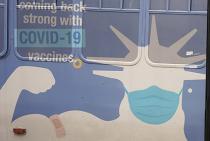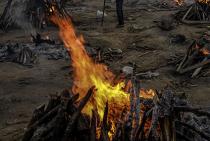New York Times reporting: The U.S. record for daily coronavirus cases has been broken, as two highly contagious variants — delta and omicron — have converged to disrupt holiday travel and gatherings, deplete hospital staffs and plunge the United States into another long winter. As a third year of the pandemic loomed, the seven-day average of U.S. cases topped 267,000 on Tuesday, according to a New York Times database.
You are here
Results for vaccination and immunization
Wednesday 29 December 2021
New York, USA
Monday 6 September 2021
Guam, Pacific Islands
Just as tourists were starting to return to Guam, the island has reported a record number of new COVID cases, a surge that is filling up hospital beds and dashing hopes of an economic recovery despite a successful vaccination campaign.
Tuesday 24 August 2021
Washington, USA
New York Times reporting: The Food and Drug Administration on Monday granted full approval to Pfizer-BioNTech’s coronavirus vaccine for people 16 years and older, a decision that is likely to set off a cascade of vaccine requirements by hospitals, colleges and universities, corporations and other organizations.
Wednesday 4 August 2021
New York, USA
New York Times reporting: The rise of the highly infectious Delta variant of the coronavirus has raised new questions about how the vaccinated can stay safe and avoid breakthrough infections. We asked the experts for advice. As long as large numbers of people remain unvaccinated, vaccinated people will be exposed to the Delta variant. “Vaccinations give you that extra protection you wouldn’t normally have,” says Dr. Erin Bromage. “But when you hit a big challenge, like getting near an unvaccinated person who has a high viral load, that wall is not always going to hold.”
Wednesday 28 April 2021
 Premium content
Premium content
New Delhi, India
New York Times reporting: Crematories are so full of bodies, it’s as if a war just happened. Fires burn around the clock. Many places are holding mass cremations, dozens at a time, and at night, in certain areas of New Delhi, the sky glows. Sickness and death are everywhere. India is recording more infections per day — as many as 350,000 — than any other country has since the pandemic began. What we had been fearing during last year’s first wave, and which never really materialized, is now happening in front of our eyes: a breakdown, a collapse, a realization that so many people will die. By Jeffrey Gettleman.
Monday 19 April 2021
 Premium content
Premium content
Thimphu, Bhutan
New York Times reporting: As of Saturday, Bhutan, a Buddhist kingdom that has emphasized its citizens’ well-being over national prosperity, had administered a first vaccine dose to more than 478,000 people, more than 60% of its population. The Health Ministry said this month that more than 93% of eligible adults had received their first shots. That rate was ahead of those of the United Kingdom and the United States, more than seven times that of neighbouring India and nearly six times the global average. Bhutan’s health minister, attributed its success to “leadership and guidance” from the country’s king, public solidarity, a general absence of vaccine hesitancy, and a primary health care system that “enabled us to take the services even to the most remote parts of the country.”
Tuesday 13 April 2021
New York, USA
New York Times reporting: The AstraZeneca-Oxford vaccine has been deployed against COVID-19 in at least 115 countries, some of them for several months now. But it was not until a few cases of a rare blood-clotting disorder — some fatal — emerged within the past month or so that many European nations began to rethink its use across all age groups. Public health experts, however, have expressed concern that publicity surrounding the rare vaccine-related reactions will fuel hesitancy. They continue to emphasize that the AstraZeneca-Oxford vaccine’s benefits far outweigh the risks. In many nations, it is the only vaccine available.
Wednesday 16 December 2020
 Premium content
Premium content
New York, USA
New York Times reporting: While many poor nations may be able to vaccinate at most 20% of their populations in 2021, some of the world’s richest countries have reserved enough doses to immunize their own multiple times over. “The high-income countries have gotten to the front of the line and cleared the shelves,” said Andrea Taylor, a Duke researcher who is studying the coronavirus vaccines contracts. But the outlook for most of the developing world is dire. Because of manufacturing limits, it could take until 2024 for many low-income countries to obtain enough vaccines to fully immunize their populations.











